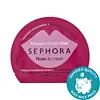What's inside
What's inside
 Key Ingredients
Key Ingredients

 Benefits
Benefits

 Ingredients Side-by-side
Ingredients Side-by-side

Water
Skin ConditioningDipropylene Glycol
HumectantMethylpropanediol
SolventGlycerin
Humectant1,2-Hexanediol
Skin ConditioningNiacinamide
SmoothingPanthenol
Skin ConditioningAllantoin
Skin ConditioningEthylhexylglycerin
Skin ConditioningTheobroma Cacao Seed Extract
AntioxidantCentella Asiatica Leaf Extract
Skin ConditioningAsiaticoside
AntioxidantMadecassic Acid
Skin ConditioningAsiatic Acid
Skin ConditioningButylene Glycol
HumectantPolyglyceryl-4 Oleate
EmulsifyingSodium Stearoyl Glutamate
CleansingPalmitoyl Tripeptide-8
Skin ConditioningPolyglyceryl-10 Laurate
Skin ConditioningCarbomer
Emulsion StabilisingTromethamine
BufferingIsopentyldiol
HumectantPropanediol
SolventXanthan Gum
EmulsifyingDextrin
AbsorbentSodium Surfactin
CleansingDextran
Citric Acid
BufferingSodium Phytate
Hydroxyacetophenone
AntioxidantCI 19140
Cosmetic ColorantCI 42090
Cosmetic ColorantWater, Dipropylene Glycol, Methylpropanediol, Glycerin, 1,2-Hexanediol, Niacinamide, Panthenol, Allantoin, Ethylhexylglycerin, Theobroma Cacao Seed Extract, Centella Asiatica Leaf Extract, Asiaticoside, Madecassic Acid, Asiatic Acid, Butylene Glycol, Polyglyceryl-4 Oleate, Sodium Stearoyl Glutamate, Palmitoyl Tripeptide-8, Polyglyceryl-10 Laurate, Carbomer, Tromethamine, Isopentyldiol, Propanediol, Xanthan Gum, Dextrin, Sodium Surfactin, Dextran, Citric Acid, Sodium Phytate, Hydroxyacetophenone, CI 19140, CI 42090
Water
Skin ConditioningButylene Glycol
HumectantGlycerin
HumectantPropanediol
SolventArginine
MaskingCarbomer
Emulsion StabilisingXanthan Gum
EmulsifyingPanthenol
Skin ConditioningAllantoin
Skin ConditioningSodium Hyaluronate
HumectantSodium Citrate
BufferingPhenoxyethanol
PreservativeDipotassium Glycyrrhizate
HumectantPolysorbate 20
EmulsifyingDisodium EDTA
Tocopheryl Acetate
AntioxidantMangifera Indica Fruit Extract
Skin ConditioningLeontopodium Alpinum Extract
Skin ConditioningRosa Centifolia Flower Extract
AstringentWater, Butylene Glycol, Glycerin, Propanediol, Arginine, Carbomer, Xanthan Gum, Panthenol, Allantoin, Sodium Hyaluronate, Sodium Citrate, Phenoxyethanol, Dipotassium Glycyrrhizate, Polysorbate 20, Disodium EDTA, Tocopheryl Acetate, Mangifera Indica Fruit Extract, Leontopodium Alpinum Extract, Rosa Centifolia Flower Extract
 Reviews
Reviews

Ingredients Explained
These ingredients are found in both products.
Ingredients higher up in an ingredient list are typically present in a larger amount.
Allantoin is a soothing ingredient known for its protective and moisturizingg properties. Because of this, it is often added to products with strong active ingredients.
Studies show higher concentrations of this ingredient can promote wound healing.
Though it can be derived from the comfrey plant, allantoin is produced synthetically for cosmetic products to ensure purity.
Learn more about AllantoinButylene Glycol (or BG) is used within cosmetic products for a few different reasons:
Overall, Butylene Glycol is a safe and well-rounded ingredient that works well with other ingredients.
Though this ingredient works well with most skin types, some people with sensitive skin may experience a reaction such as allergic rashes, closed comedones, or itchiness.
Learn more about Butylene GlycolCarbomer is a polymer of acrylic acid. Its main role is to create a gel consistency.
A high amount of carbomer can cause pilling or balling up of products. Don't worry, most products contain 1% or less of carbomer.
Glycerin is already naturally found in your skin. It helps moisturize and protect your skin.
A study from 2016 found glycerin to be more effective as a humectant than AHAs and hyaluronic acid.
As a humectant, it helps the skin stay hydrated by pulling moisture to your skin. The low molecular weight of glycerin allows it to pull moisture into the deeper layers of your skin.
Hydrated skin improves your skin barrier; Your skin barrier helps protect against irritants and bacteria.
Glycerin has also been found to have antimicrobial and antiviral properties. Due to these properties, glycerin is often used in wound and burn treatments.
In cosmetics, glycerin is usually derived from plants such as soybean or palm. However, it can also be sourced from animals, such as tallow or animal fat.
This ingredient is organic, colorless, odorless, and non-toxic.
Glycerin is the name for this ingredient in American English. British English uses Glycerol/Glycerine.
Learn more about GlycerinPanthenol is a common ingredient that helps hydrate and soothe the skin. It is found naturally in our skin and hair.
There are two forms of panthenol: D and L.
D-panthenol is also known as dexpanthenol. Most cosmetics use dexpanthenol or a mixture of D and L-panthenol.
Panthenol is famous due to its ability to go deeper into the skin's layers. Using this ingredient has numerous pros (and no cons):
Like hyaluronic acid, panthenol is a humectant. Humectants are able to bind and hold large amounts of water to keep skin hydrated.
This ingredient works well for wound healing. It works by increasing tissue in the wound and helps close open wounds.
Once oxidized, panthenol converts to pantothenic acid. Panthothenic acid is found in all living cells.
This ingredient is also referred to as pro-vitamin B5.
Learn more about PanthenolPropanediol is an all-star ingredient. It softens, hydrates, and smooths the skin.
It’s often used to:
Propanediol is not likely to cause sensitivity and considered safe to use. It is derived from corn or petroleum with a clear color and no scent.
Learn more about PropanediolWater. It's the most common cosmetic ingredient of all. You'll usually see it at the top of ingredient lists, meaning that it makes up the largest part of the product.
So why is it so popular? Water most often acts as a solvent - this means that it helps dissolve other ingredients into the formulation.
You'll also recognize water as that liquid we all need to stay alive. If you see this, drink a glass of water. Stay hydrated!
Learn more about WaterXanthan gum is used as a stabilizer and thickener within cosmetic products. It helps give products a sticky, thick feeling - preventing them from being too runny.
On the technical side of things, xanthan gum is a polysaccharide - a combination consisting of multiple sugar molecules bonded together.
Xanthan gum is a pretty common and great ingredient. It is a natural, non-toxic, non-irritating ingredient that is also commonly used in food products.
Learn more about Xanthan Gum